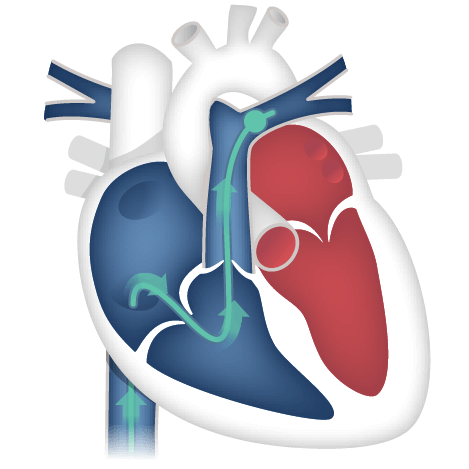How is PAH diagnosed?
PAH is rare and can be difficult to diagnose. Many patients have PAH for more than 2 years before being diagnosed.
If your healthcare provider suspects you may have PAH based on your symptoms, they may put you through a variety of tests to help confirm or rule out a diagnosis of PAH.
-
A review of your medical history and previous physical exams
After an initial physical exam, your healthcare provider will look for signs and symptoms of PAH in your medical history and review results of previous exams. You also may be asked about your family history, because PAH can be inherited.
-
Chest x-rays
A chest x-ray may show an enlargement of the right ventricle. This is a sign that your heart has been working harder than normal to push blood through narrowed blood vessels in the lungs.
-
A pulmonary function test (PFT)
This test measures
- How much air your lungs can hold
- How much air moves through your lungs
- How quickly air is pushed through your lungs
A PFT helps your healthcare provider determine if there are any issues with the function of your lungs.
-
An echocardiogram (Echo)
This test measures the size and shape of your heart. It also measures how well the heart squeezes and relaxes.
-
An NT-proBNP/BNP blood test
When your heart works harder than usual, it releases high levels of molecules found naturally in your body. These include the hormone called B-type natriuretic peptide, or BNP, and its precursor, NT-proBNP.
If this test shows high levels of BNP, it means your heart is straining and working harder than normal. The strain may be caused by narrow blood vessels in the lungs because of PAH.
-
A ventilation perfusion scan (VQ)
This 2-part test measures your breathing and the blood flow in your lungs. The test is used to determine if there are blood clots in your lungs, which can cause high blood pressure.
If your healthcare provider finds 1 or more blood clot(s) in your lungs, they may determine you do not have group 1 pulmonary arterial hypertension (PAH), but a different kind of pulmonary hypertension.
-
Right heart catheterization (cath)
This is currently the only test that can diagnose PAH. This procedure also reveals how much blood your heart pumps through the lungs. In addition, it helps determine the severity of your PAH, which is an important factor in prognosis.
Is there a cure for PAH?
Although there is no cure for PAH, research continues. Scientific or clinical PAH studies are continually being conducted. Ongoing advances can contribute to earlier diagnosis of PAH and longer, more effective management.
What happens after you’ve been diagnosed with PAH?
After you have been diagnosed with PAH, your healthcare provider will use some of the same tests that were used to confirm PAH to create a treatment plan that is tailored to your needs. A lot of considerations go into your PAH treatment plan, including a very important factor called risk status.
PAH knowledge is PAH power
A right heart catheterization is currently the only procedure that can tell whether PAH is the cause of high blood pressure in your heart and pulmonary arteries.
-
Correct. The answer is “true.” Right heart catheterization is a procedure that also helps determine the severity of your PAH, which is an important factor in prognosis.
-
Incorrect. The answer is “true.” Right heart catheterization is a procedure that also helps determine the severity of your PAH, which is an important factor in prognosis and for treatment decisions.

If your NT-proBNP/BNP blood test shows high levels of NT-proBNP/BNP, it means:
-
Incorrect. If this test shows high levels of NT-proBNP/BNP, it means your heart is straining and working harder than normal. The strain may be caused by narrow blood vessels in the lungs from PAH. With PAH, the narrow blood vessels in the lungs cause the heart to work harder than normal.
-
Correct! If this test shows high levels of NT-proBNP/BNP, it means your heart is straining and working harder than normal. The strain may be caused by narrow blood vessels in the lungs from PAH. With PAH, the narrow blood vessels in the lungs cause the heart to work harder than normal.

Understanding today’s risk-based approach to your PAH
Managing your symptoms and achieving stability are important in PAH. But today, there’s something more—a scientific approach called risk assessment. Risk assessment reflects the latest thinking about treating PAH, and it has been validated by research. Risk assessment is an established practice among PAH experts and has become part of the standard of care for treating PAH.
Risk status focuses on how you’re doing now, how you can feel better today, and how you may be doing in the future.
What Is Risk Status?